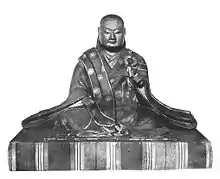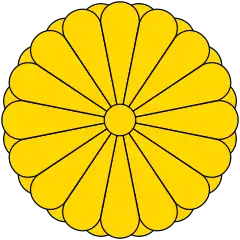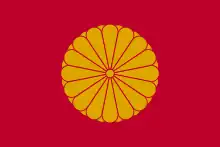| Emperor Go-Nara 後奈良天皇 | |||||
|---|---|---|---|---|---|
 Seated figure of Emperor Go-Nara | |||||
| Emperor of Japan | |||||
| Reign | June 9, 1526 – September 27, 1557 | ||||
| Coronation | March 29, 1535 | ||||
| Predecessor | Go-Kashiwabara | ||||
| Successor | Ōgimachi | ||||
| Shōguns | See list | ||||
| Born | Tomohito (知仁) January 26, 1495 | ||||
| Died | September 27, 1557 (aged 62) | ||||
| Burial | Fukakusa no kita no misasagi (深草北陵) Kyoto | ||||
| Issue among others... | Emperor Ōgimachi | ||||
| |||||
| House | Yamato | ||||
| Father | Emperor Go-Kashiwabara | ||||
| Mother | Fujiwara Fujiko | ||||
| Signature |  | ||||
Emperor Go-Nara (後奈良天皇, Go-Nara-tennō, January 26, 1495 – September 27, 1557)[1] was the 105th Emperor of Japan, according to the traditional order of succession. He reigned from June 9, 1526, until his death in 1557, during the Sengoku period.[1] His personal name was Tomohito (知仁).[2]
Genealogy
He was the second son of Emperor Go-Kashiwabara. His mother was Fujiwara Fujiko (藤原藤子)
- Nyōin: Madenokōji (Fujiwara) Eiko (万里小路栄子; 1499–1522), Madenokōji Katafusa's daughter
- First daughter: (1514–1515)
- First son: Imperial Prince Michihito (方仁親王) later Emperor Ōgimachi
- Second daughter: Princess Eiju (1519–1535; 永寿女王)
- Second Son: (1521–1530)
- Lady-in-waiting: Takakura (Fujiwara) Kazuko? (高倉(藤原)量子), Tachibana Yukio's daughter
- Fifth daughter: Princess Fukō? (d.1579; 普光女王)
- Lady-in-waiting: Hirohashi (Fujiwara) Kuniko? (広橋(藤原)国子), Hirohashi Kanehide's daughter
- Seventh daughter: Princess Seishū (1552–1623; 聖秀女王)
- Naishi: Fujiwara (Hino) Tomoko, Minase Hidekane's daughter
- Court lady: Iyo-no-Tsubone (伊予局), Mibu Harutomi's Daughter
- Third son: kakujyo (1521–1574; 覚恕)
- Court lady: Daughter of Jimyoin Motoharu
- Princess (Twins, 1520)
- Princess (Twins, 1520)
- Court lady: Daughter of Imperial Prince Tokiwai Tsunenao
Events of Go-Nara's life
- Daiei 6, in the 4th month (June 9, 1526): Go-Nara was proclaimed emperor upon the death of his father, Emperor Go-Kashiwabara. He began his reign at age 31.[3]
- Daiei 6, 7th month (1526): An army from Awa Province marched towards Miyako. Hosokawa Takakuni attacked these forces at the Katsura River, but his forces were unsuccessful. Hosokawa Takakage came to the aid of Takakuni, and their combined forces were successful in stopping the advancing army.[4]
- Daiei 6, 12th month (1526): Shōgun Ashikaga Yoshiharu invited archers from neighboring provinces to come to the capital for an archery contest.[4]
- Kyōroku gannen or Kyōroku 1 (1528): Former Kampuku Konoe Tanye became Sadaijin. The former Nadaijin Minamoto-no Mitsukoto became Udaijin. Former Dainagon Kiusho Tanemitsu became Nadaijin.[4]
- Tenbun 5, 26th day of 2nd month (1536): Go-Nara was formally installed as emperor.[5] The Imperial Court was so impoverished, that a nationwide appeal for contributions went out. Contributions from the Hōjō clan, the Ōuchi clan, the Imagawa clan, and other great daimyō clans of the Sengoku period allowed the Emperor to carry out the formal coronation ceremonies ten years later. The Imperial Court's poverty was so extreme that the Emperor was forced to sell his calligraphy.
- Tenbun 11, 25th day of the 8th month (1543): Portuguese ship drifts ashore at Tanegashima, and European guns are introduced into Japan.
- Tenbun 20, 8th to 9th month (1551): Courtiers in preparation to move the emperor from war-torn Kyoto to the Ōuchi city of Yamaguchi were caught in the Tainei-ji incident, a coup within the Ōuchi clan. The massacre of the courtiers in Yamaguchi resulted in a widespread loss of court records along with knowledge of court rituals and imperial calendar-making.[6] The emperor remained in Kyoto.
- Kōji 3, 5th day of 9th month (1557): Emperor Go-Nara died at age 62.[7] He was unburied for 70 days.[8]
Go-Nara is enshrined with other emperors at the imperial tomb called Fukakusa no kita no misasagi (深草北陵) in Fushimi-ku, Kyoto.[9]
Kugyō
Kugyō (公卿) is a collective term for the very few most powerful men attached to the court of the Emperor of Japan in pre-Meiji eras. Even during those years in which the court's actual influence outside the palace walls was minimal, the hierarchic organization persisted.
In general, this elite group included only three to four men at a time. These were hereditary courtiers whose experience and background would have brought them to the pinnacle of a life's career. During Go-Nara's reign, this apex of the Daijō-kan included:
Eras of Go-Nara's reign
The years of Go-Nara's reign are more specifically identified by more than one era name or nengō.[11]
Ancestry
| Ancestors of Emperor Go-Nara[12] | |||||||||||||||||||||||||||||||||||||||||||||||||||||||||||||||||||||||||||||||||||||||||||||||||||||||||||||||||||||||||||||||||||||||||||||||||||||||||||||||||||||||||||||||||||||||||||||||||||||||||||||||||||||||||||||||||||||||||||||||||||||||||||||||||||||||||
|---|---|---|---|---|---|---|---|---|---|---|---|---|---|---|---|---|---|---|---|---|---|---|---|---|---|---|---|---|---|---|---|---|---|---|---|---|---|---|---|---|---|---|---|---|---|---|---|---|---|---|---|---|---|---|---|---|---|---|---|---|---|---|---|---|---|---|---|---|---|---|---|---|---|---|---|---|---|---|---|---|---|---|---|---|---|---|---|---|---|---|---|---|---|---|---|---|---|---|---|---|---|---|---|---|---|---|---|---|---|---|---|---|---|---|---|---|---|---|---|---|---|---|---|---|---|---|---|---|---|---|---|---|---|---|---|---|---|---|---|---|---|---|---|---|---|---|---|---|---|---|---|---|---|---|---|---|---|---|---|---|---|---|---|---|---|---|---|---|---|---|---|---|---|---|---|---|---|---|---|---|---|---|---|---|---|---|---|---|---|---|---|---|---|---|---|---|---|---|---|---|---|---|---|---|---|---|---|---|---|---|---|---|---|---|---|---|---|---|---|---|---|---|---|---|---|---|---|---|---|---|---|---|---|---|---|---|---|---|---|---|---|---|---|---|---|---|---|---|---|---|---|---|---|---|---|---|---|---|---|---|---|---|---|---|---|
| |||||||||||||||||||||||||||||||||||||||||||||||||||||||||||||||||||||||||||||||||||||||||||||||||||||||||||||||||||||||||||||||||||||||||||||||||||||||||||||||||||||||||||||||||||||||||||||||||||||||||||||||||||||||||||||||||||||||||||||||||||||||||||||||||||||||||
Notes

- 1 2 後奈良天皇 [Emperor Go-Nara]. Kotobank. Archived from the original on September 26, 2023. Retrieved September 26, 2023.
- ↑ Titsingh, Isaac. (1834). Annales des empereurs du japon, pp. 372–382.
- ↑ Titsingh, p. 372; Varley, H. Paul. (1980). Jinnō Shōtōki, p. 44; n.b., a distinct act of senso is unrecognized prior to Emperor Tenji; and all sovereigns except Jitō, Yōzei, Go-Toba, and Fushimi have senso and sokui in the same year until the reign of Emperor Go-Murakami.
- 1 2 3 Titsingh, p. 373.
- ↑ Titsingh, p. 374.
- ↑ Conlan, Thomas (2015). "The Failed Attempt to Move the Emperor to Yamaguchi and the Fall of the Ōuchi". Japanese Studies. 35 (2): 193. doi:10.1080/10371397.2015.1077679. S2CID 143369274. Retrieved 6 March 2016.
- ↑ Titsingh, p. 382.
- ↑ Conlan, p. 198
- ↑ Ponsonby-Fane, Richard. (1959). The Imperial House of Japan, p. 423.
- ↑ Citation based on 近衛前久, retrieved from the Japanese Wikipedia on July 14, 2007.
- ↑ Titsingh, p. 372.
- ↑ "Genealogy". Reichsarchiv (in Japanese). Retrieved 25 January 2018.
References
- Ponsonby-Fane, Richard Arthur Brabazon. (1959). The Imperial House of Japan. Kyoto: Ponsonby Memorial Society. OCLC 194887
- Titsingh, Isaac, ed. (1834). [Siyun-sai Rin-siyo/Hayashi Gahō, 1652], Nipon o daï itsi ran; ou, Annales des empereurs du Japon. Paris: Oriental Translation Fund of Great Britain and Ireland.
- Varley, H. Paul, ed. (1980). [ Kitabatake Chikafusa, 1359], Jinnō Shōtōki (A Chronicle of Gods and Sovereigns: Jinnō Shōtōki. New York: Columbia University Press. ISBN 0-231-04940-4
